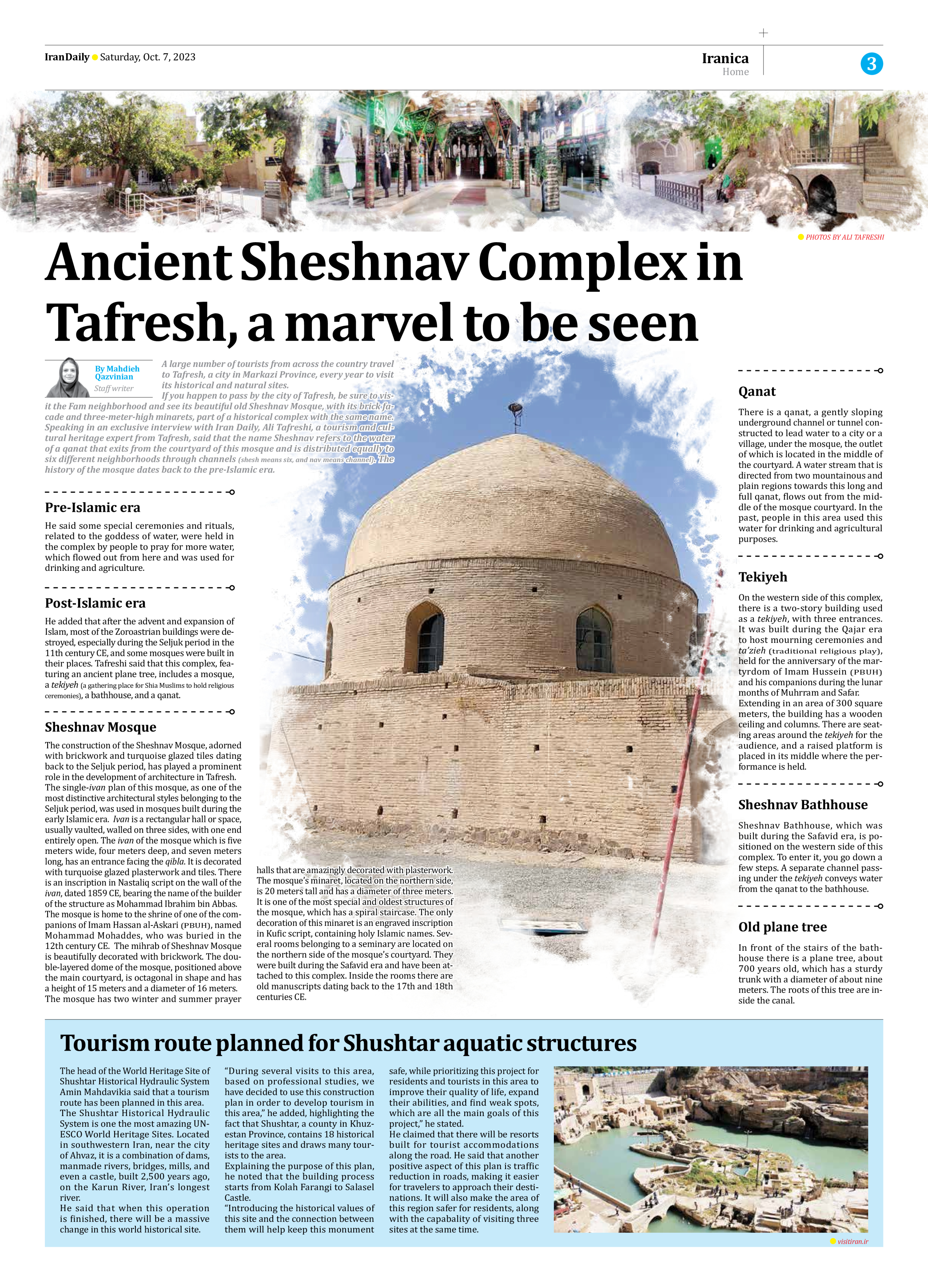
Ancient Sheshnav Complex in Tafresh, a marvel to be seen
By Mahdieh Qazvinian
Staff writer
A large number of tourists from across the country travel to Tafresh, a city in Markazi Province, every year to visit its historical and natural sites.
If you happen to pass by the city of Tafresh, be sure to visit the Fam neighborhood and see its beautiful old Sheshnav Mosque, with its brick facade and three-meter-high minarets, part of a historical complex with the same name.
Speaking in an exclusive interview with Iran Daily, Ali Tafreshi, a tourism and cultural heritage expert from Tafresh, said that the name Sheshnav refers to the water of a qanat that exits from the courtyard of this mosque and is distributed equally to six different neighborhoods through channels (shesh means six, and nav means channel). The history of the mosque dates back to the pre-Islamic era.
Pre-Islamic era
He said some special ceremonies and rituals, related to the goddess of water, were held in the complex by people to pray for more water, which flowed out from here and was used for drinking and agriculture.
Post-Islamic era
He added that after the advent and expansion of Islam, most of the Zoroastrian buildings were destroyed, especially during the Seljuk period in the 11th century CE, and some mosques were built in their places. Tafreshi said that this complex, featuring an ancient plane tree, includes a mosque, a tekiyeh (a gathering place for Shia Muslims to hold religious ceremonies), a bathhouse, and a qanat.
Sheshnav Mosque
The construction of the Sheshnav Mosque, adorned with brickwork and turquoise glazed tiles dating back to the Seljuk period, has played a prominent role in the development of architecture in Tafresh.
The single-ivan plan of this mosque, as one of the most distinctive architectural styles belonging to the Seljuk period, was used in mosques built during the early Islamic era. Ivan is a rectangular hall or space, usually vaulted, walled on three sides, with one end entirely open. The ivan of the mosque which is five meters wide, four meters deep, and seven meters long, has an entrance facing the qibla. It is decorated with turquoise glazed plasterwork and tiles. There is an inscription in Nastaliq script on the wall of the ivan, dated 1859 CE, bearing the name of the builder of the structure as Mohammad Ibrahim bin Abbas.
The mosque is home to the shrine of one of the companions of Imam Hassan al-Askari (PBUH), named Mohammad Mohaddes, who was buried in the 12th century CE. The mihrab of Sheshnav Mosque is beautifully decorated with brickwork. The double-layered dome of the mosque, positioned above the main courtyard, is octagonal in shape and has a height of 15 meters and a diameter of 16 meters.
The mosque has two winter and summer prayer halls that are amazingly decorated with plasterwork. The mosque’s minaret, located on the northern side, is 20 meters tall and has a diameter of three meters. It is one of the most special and oldest structures of the mosque, which has a spiral staircase. The only decoration of this minaret is an engraved inscription in Kufic script, containing holy Islamic names. Several rooms belonging to a seminary are located on the northern side of the mosque’s courtyard. They were built during the Safavid era and have been attached to this complex. Inside the rooms there are old manuscripts dating back to the 17th and 18th centuries CE.
Qanat
There is a qanat, a gently sloping underground channel or tunnel constructed to lead water to a city or a village, under the mosque, the outlet of which is located in the middle of the courtyard. A water stream that is directed from two mountainous and plain regions towards this long and full qanat, flows out from the middle of the mosque courtyard. In the past, people in this area used this water for drinking and agricultural purposes.
Tekiyeh
On the western side of this complex, there is a two-story building used as a tekiyeh, with three entrances. It was built during the Qajar era to host mourning ceremonies and ta’zieh (traditional religious play), held for the anniversary of the martyrdom of Imam Hussein (PBUH) and his companions during the lunar months of Muhrram and Safar.
Extending in an area of 300 square meters, the building has a wooden ceiling and columns. There are seating areas around the tekiyeh for the audience, and a raised platform is placed in its middle where the performance is held.
Sheshnav Bathhouse
Sheshnav Bathhouse, which was built during the Safavid era, is positioned on the western side of this complex. To enter it, you go down a few steps. A separate channel passing under the tekiyeh conveys water from the qanat to the bathhouse.
Old plane tree
In front of the stairs of the bathhouse there is a plane tree, about 700 years old, which has a sturdy trunk with a diameter of about nine meters. The roots of this tree are inside the canal.







